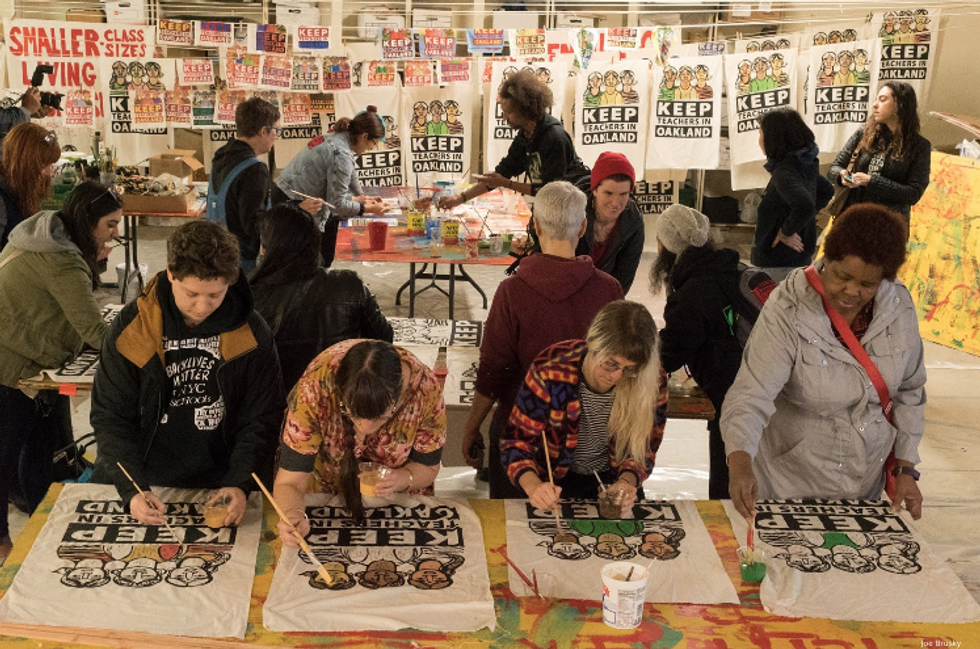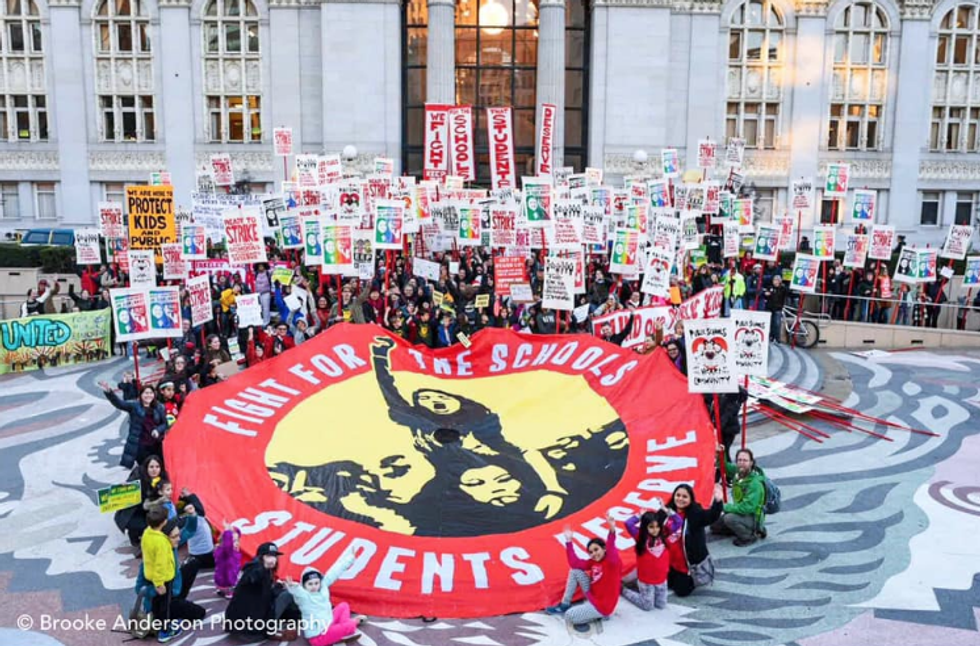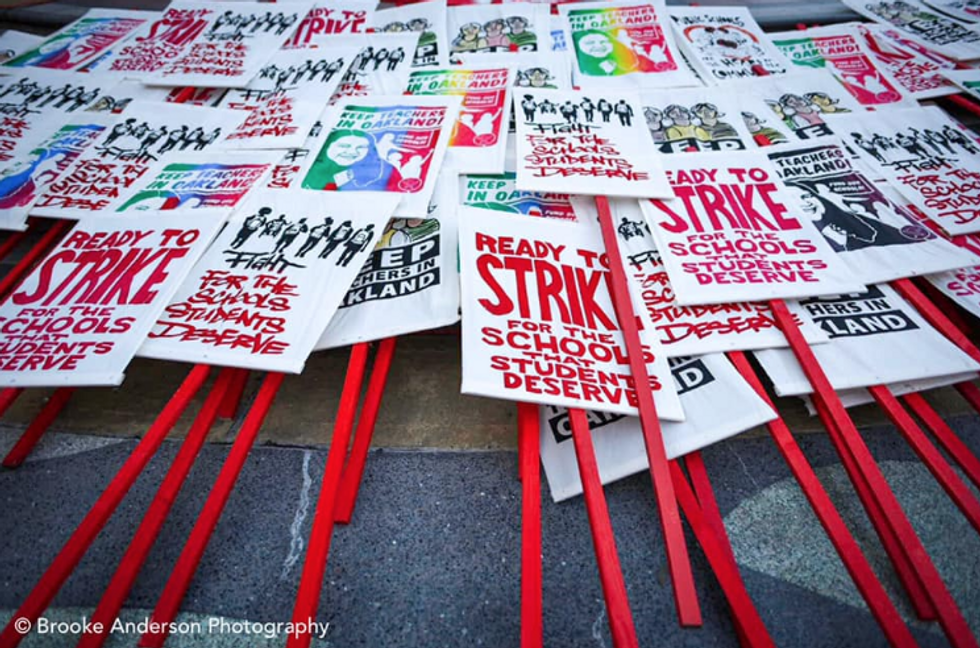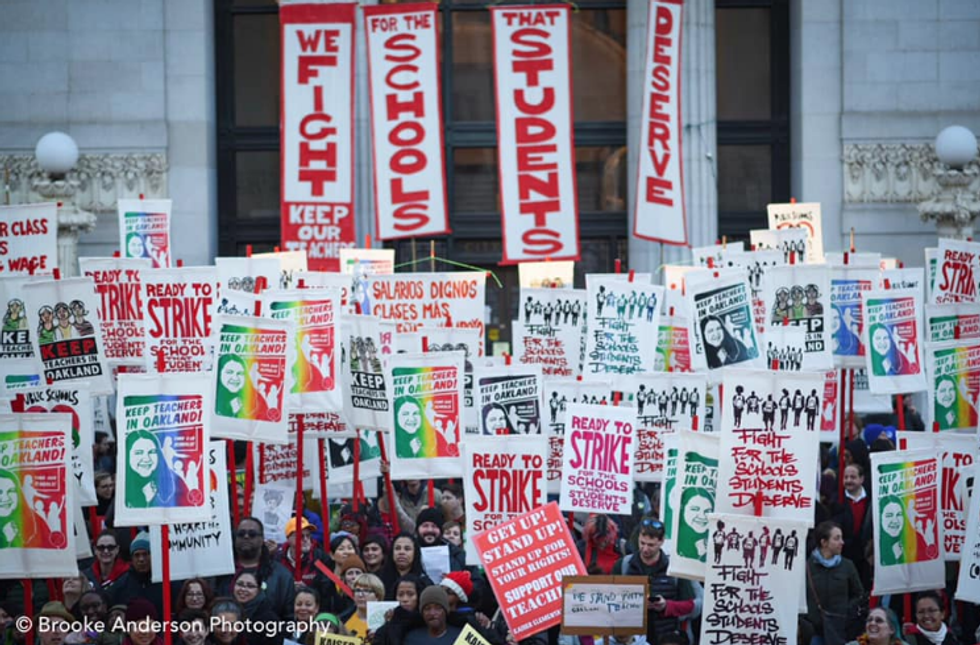"The Power of Youth. The Power of Educators. The Power of Labor. The Power of Community. The Power of The Art Build."
--Keith Brown, President, Oakland Education Association
"Culture is a space where we can introduce ideas, attach emotions to concrete change and win enthusiasm for our values. Art is where we can change the narrative, because it's where people can imagine what change looks and feels like."
--Favianna Rodriguez, one of the artist's contributing artwork to the Oakland teachers strike.
Surrounded by a hundred teachers and supporters painting banners, screen printing fabric picket flags, and learning strike songs, Oakland teachers union president Keith Brown held a press conference announced that Oakland teachers would hold a strike vote. Every square inch of the union hall offices and parking garage was filled with people making art and singing strike songs. This is one key part of how Oakland teachers built momentum and got ready to strike. The victorious Los Angeles teachers strike last month held a similar pre-strike arts mobilization. Teacher and union arts organizer Joe Brusky says, "the art created for L.A. played a major role in winning a victory."
For the last two months a massive #strike-ready art-making collaboration between the Oakland Education Association, local artists and a team of arts organizers has been building momentum, participation and created thousands of pieces of hand made art that has been used in public actions leading up to the strike and will be seen on the picket lines.
San Francisco Bay Area socially engaged artists Favianna Rodriguez, Micah Bazant, Miriam Stahl, Eric Norbert, Melanie Cervantes and Jesus Baraza, Kim Cosier, Emory Douglas, Claudio Martinez, Jeanette Arellano and Paul Kjelland all contributed designs to support the teachers, and teachers and students also contributed designs.
Joe together with a team of artist-organizers from Milwaukee (Kim Cosier, Nicolas Lampert, Paul Kjelland, Claudio Martinez, and Josie Osborne) started this model of ambitious large scale art builds for teachers unions. They went on to co-organize the art builds in Los Angeles and Oakland, where I was the local arts organizer working with Oakland teachers. Joe, a photo journalist, was the UTLA teachers union official photographer for the LA Strike, both documenting and pushing out images and stories on social media like Facebook, Instagram and Twitter. Lu Aya of the Peace Poets worked with teachers to write and train each other on strike songs.
Milwaukee art team member and artist-education Nicolas Lampert writes, "Art builds - at their core - are community building events. They produce banners, picket signs, patches, and signs for the movement, but more so they brings together teachers, students, parents, and the community in a common struggle. The OEA art build was no different and the OEA union space and their parking garage was transformed into an art build space with hundreds of people taking part, often staying for six-to-eight hour shifts or longer."
For two decades I have been organizing arts with a range of movements--from the shutdown of the WTO in Seattle in 1999 and other global justice mobilization to the victories of the Florida farm workers of the Coalition of Immokalee Workers, to the climate justice movement marches and actions-- bringing the arts into the center of our organizing, education and actions. I have never seen a national union place arts at the center of the strategy to win, as the National Education Association has.
I asked Joe some questions about how this all happened and about it's impact. Here's what he said.
How did you start making art with teachers' unions? What impact or use did it have for teachers' fights?
I guess the beginning of my making art with teachers' unions was bringing Overpass Light Brigade (after-dark visibility action using l.e.d.-lit words on signs) messages to school board meetings, but my first art build with the Milwaukee Teachers' Education Association was in February, 2017. I had been to the People's Climate March in NYC in 2014 and was in the May Day Space to see that art build. I also saw art builds in Milwaukee for the group Voces de la Frontera. I saw immediately the power of those events and I figured we could apply the idea to public education advocacy and union issues, so we organized one to build protest ephemera (art) for a series of budget hearings taking place around the state.
That art build was transformative for our union. We brought many new activists and artists into the union movement in addition to building a huge inventory of signs, posters, and banners. We activated many local artists who designed images but also started to become more involved. They started showing up to school board meetings, public hearings, and actions organized around our issues. The art was well received and we got requests from around the country to use the art and share the idea. The art traveled with the budget hearing around the state and we saw photos posted around the state of the art made in Milwaukee, so the effect was massive.
How did it come about that the NEA made art builds a major part of the support for striking teachers unions?
NEA took notice of our first MKE art build and a subsequent art build in Minneapolis, and wanted to try and replicate some of the ideas for their National Conference on Racial and Social Justice in June 2018 in Minneapolis. We painted 15 parachute banners on the conference floor over two days with participants from all over the country. NEA loved the idea and the high level of participation from conference goers. They knew they wanted to expand the idea nationally, and the L.A. strike happened to be coming up around the same time. They also noticed the buzz we created using social media around the art build -- and the creation of photos from the art build could be used to generate social media content far after the event was completed. Since L.A. needed a ton of picket signs, banners, and posters, the art build idea was put to use full scale, and we've seen the success of that art in helping to build a successful victory for L.A. Teachers.
What role did the art build and the art play in the LA Teachers Strike victory? How does the art help win a strike?
I think the art created for L.A. played a major role in winning a victory. Nisha Sethi's "Teachers: We Work for the People" and Ernesto Yerena's "Stand with L.A. Teachers" both were designs created from portraits of actual California educators, which really helped humanize and personalize the fight for educators. These two images alone were visible at every action I attended. The very act of building the art together at the art build really seems to galvanize and unite those organizing on the ground. When you build the art together you want to hold the art together. The designs were able to take often very complicated education issues and made them easy to understand and sympathize with. Privatizers have purposely made the education landscape confusing, and the art produced helped make it easy to understand for all. Another powerful component was activating local artists in the struggle. The artists who designed images may have been supporters of public education, but by producing designs they publicly staked their claim as activists fighting for change. This brought many of their followers into the fold who might otherwise never have entered the movement. The L.A. images are already iconic and will forever hold special meaning.
What is the role of photo/video documentation and social media in the arts-making and the strikes . . . your role?
An art build and the actions following never happened if they aren't documented. Documentation is critical. I use social media to tell the story of the art build as it unfolds in real time. It's important to capture not only the pieces produced, but the people producing them and the reason behind their efforts. These stories not only humanize those participating, but bring the art and the struggle into the view of those who might not be informed. Our documentation has also sparked interest from other groups and has captured the audience of people who might otherwise never have supported. The art build provides amazing optics that are easily digested on social media and help to build buzz around the issue or event being organized around. Not only is the union sharing the stories and the visuals, but other participants are generating their own social media and stories as well. This exponentially increases the amount of people talking about and sharing your issue.
For strikes, my role is to just capture moments and share stories that help sustain those on the line. The beauty is, the art created in the hands of those picketing tells so much of the story on their own. As a released classroom teacher working for my union, I try to tell stories from the point of view of an educator who has been in the classroom experiencing the issues we're organizing around. This helps me when I'm interviewing or speaking to other educators. I tell them I am a teacher taking photos. They feel very comfortable taking photos or interviewing with me because they know I am one of them. It helps them let their guard down and be more real. I see my role as capturing spectacle, emotion, and joy. I want people to see my photos and feel like a part of the action. I want my photos to capture the essence of the moment but to also pull in those on the fringes waiting to be called in. Social media must occur before, during and following an art build or strike. I've found the images I use live on long after they are posted. Since I put a non-commercial, attribution creative commons license on my photos, they are used far and wide by other unions, non-profits, and independent media outlets. I want to provide these groups with quality content they can use to help build wherever they are. I also tag my photos so they are easy to find on Google searches and the World Wide Web.
All photos throughout by Joe Brusky or Brooke Anderson. Some related links for this article:
Joe Brusky photos
Brooke Anderson Photos Essay: Oakland Teachers Ready to Strike
Art Build Video: Fighting to Keep Teachers in Oakland
CBS NEWS: Oakland Teachers Hold 'Art Build' To Make Statements Ahead Of Potential Strike






